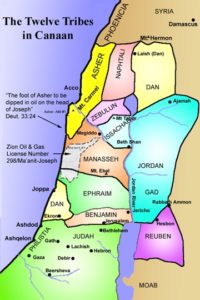“Of Y’hudah he said:
‘Hear, Adonai, the cry of Y’hudah!
Bring him in to his people,
let his own hands defend him;
but you, help him against his enemies.'”
-Deuteronomy 33:7
Following Reuben, the next blessing up is Judah.
However, let’s pause here for a second to address a question that may or may not be on some of your minds.
How can one explain the order of names in the tribal listing in the Blessing of Moses?
What’s the one discernible pattern we can find that would make sense?
For instance it’s pretty apparent that the order of names has nothing to do with how the tribes were set up in groups of three around the Wilderness Tabernacle (the military battle order).
Nor did it have anything to do with birth order.
Sure Reuben was indeed the firstborn but Judah was NOT the second born.
So we can cross both of these possibilities off our list.
Some folks think it may have to do with which children were born to which mother.
However, that idea doesn’t hold water either.
Leah’s four children are mentioned first but then after that the order of the names gets muddled.
So what’s the answer?
The answer is (drum roll)….
…the order of tribes in the Blessing of Moses…
…is based on the geographical territories assigned to each tribe.
Take a look at the ancient map of Canaan I posted up above.
Starting with Reuben in the Transjordan (where Moses is now standing), they would first cross into the Promised Land into the territory that Judah would inherit.
That’s why Judah in the order of blessings comes after Reuben.
Next the blessings of Levi are given and then we move northward to the territory of Benjamin and onward into the region the Joseph tribes inherited or Ephraim and Manasseh.
The next tribal territory is Zebulun followed by his neighbor to the east which is Issachar.
We continue to move east until we cross back over the Jordan River and onward into the territory of Gad.
We then make a shift to the north up to Dan and then pivot left to the west into Naphtali territory.
After leaving Naphtali land we continue to head west which brings us smack dab right into Asher territory.
Well, there you have it folks.
A perfectly logical reason explanation for the order of the tribes in the Blessing of Moses.
Isn’t it fascinating how the blessings of God are linked to the land of God?
Some of you may ask…
…given that Levi wasn’t given any territory, why were they sandwiched between Judah and Benjamin in the list of names?
This is because they would one day reside in the area where Jerusalem would exist.
This makes perfect sense because it would be the Levites who would serve at the Temple.
Onward, let’s get back to the nature of Judah’s blessing.
Moses’ words seem to predict a future time when Judah will be at war and will need divine assistance from on high in order to prevail.
Moses beseeches the Lord to keep the soldiers of Judah safe in their battles with the enemy.
Interestingly the word Moses uses in his prayer to Hashem is a term we should all be familiar with: SHEMA.
Remember SHEMA means to listen AND OBEY.
It does not mean to passively process information through our ears and then do nothing after that.
The reason I said this was interesting is because up until now it was the Lord who asked His people to SHEMA (listen and obey) Him.
However, now it’s the reverse.
Moses is now asking the Lord to SHEMA or to listen and take vigorous action on behalf of Judah to protect her in her future battles.




Leave a Reply